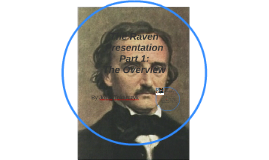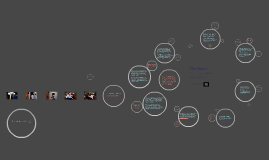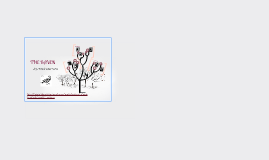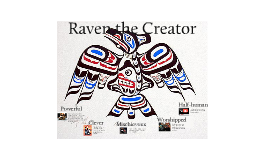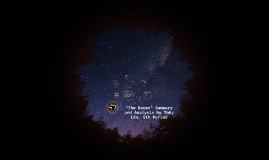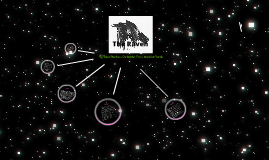The Raven Presentation
Transcript: In this scene, the man is sitting in his chair and staring at the raven to find its meaning. He suddenly realizes that the raven was bringing back the memories of Lenore. Nevermore is used as the end rhyme for the rest of the poem for each stanza. The word never gives you the sense that something will never happen again. You can't be sure whether that's a good thing or a bad thing. This makes you want to read the poem more. Edgar Allan Poe uses good techniques to keep people hooked on such a long poem like this one. A B C B B B When he says "Darkness there and nothing more", it really gives you a sense of how scared this guy is right now. He's just sitting here alone and hears knocking at his door. He finally builds up his courage and opens the door. All there is is darkness. How can I relate to this poem? Thanks for Watching!!! Here I'm starting to notice a lot of repetition on the words nothing more To hear the whole poem click here--> This stanza presents an new character named Lenore. From other details, you can tell that Lenore was lost somehow (not literally lost). I also think that this man is mourning her death because he loved her. He described her as rare and radiant. If you didn't read the title, you would have never guessed that a raven would be the one to step inside his chamber. Even more alliteration is evident here. These include the phrases "whispered word" and "Doubting, dreaming dreams". The dark is scary!! So far, I think it is really impressive how Edgar Allan Poe tends to keep the rhythm and the rhyme of this poem, without changing the topic and keeping the 2nd, 4th, 5th, and 6th lines of each stanza to end in the sound of ore. `Be that word our sign of parting, bird or fiend!' I shrieked upstarting - `Get thee back into the tempest and the Night's Plutonian shore! Leave no black plume as a token of that lie thy soul hath spoken! Leave my loneliness unbroken! - quit the bust above my door! Take thy beak from out my heart, and take thy form from off my door!' Quoth the raven, `Nevermore.' And the raven, never flitting, still is sitting, still is sitting On the pallid bust of Pallas just above my chamber door; And his eyes have all the seeming of a demon's that is dreaming, And the lamp-light o'er him streaming throws his shadow on the floor; And my soul from out that shadow that lies floating on the floor Shall be lifted - nevermore! Ah, distinctly I remember it was in the bleak December, And each separate dying ember wrought its ghost upon the floor. Eagerly I wished the morrow; - vainly I had sought to borrow From my books surcease of sorrow - sorrow for the lost Lenore - For the rare and radiant maiden whom the angels named Lenore - Nameless here for evermore. At this point in the poem, you realize that the raven was just a metaphor in the whole poem. I think that the raven symbolizes the memory of Lenore and that the raven is trying to bring those memories back to the man that is trying to forget. That is why the man, all of a sudden, starts to yell at the raven at how evil it is. When he says "nothing more" he's literally saying that there is nothing more to the story and it's almost as if Edgar Allan Poe is telling you to stop reading. This is a good way to make the reader keep reading because they know that there is much more. It's almost like saying "don't touch that. It's just too soft and fluffy for you to touch it". All that does is make you want to touch the thing more. Asleep `Prophet!' said I, `thing of evil! - prophet still, if bird or devil! - Whether tempter sent, or whether tempest tossed thee here ashore, Desolate yet all undaunted, on this desert land enchanted - On this home by horror haunted - tell me truly, I implore - Is there - is there balm in Gilead? - tell me - tell me, I implore!' Quoth the raven, `Nevermore.' `Prophet!' said I, `thing of evil! - prophet still, if bird or devil! By that Heaven that bends above us - by that God we both adore - Tell this soul with sorrow laden if, within the distant Aidenn, It shall clasp a sainted maiden whom the angels named Lenore - Clasp a rare and radiant maiden, whom the angels named Lenore?' Quoth the raven, `Nevermore.' After being totally declined by a raven, the man is shouting for it to get out of his house and for it to leave and go back wherever it came from. Still, the raven stays put. In the last stanza, the man finally falls into the ravens curse and will be depressed as long as the raven is there with him. The second of these two stanzas present a new word that is repeated: Nevermore. This is one of the first times in the poem where Edgar Allan Poe uses alliteration. He says "entreating entrance". Both of these words start with "entr". This helps the poem not only with keeping its rhythm, but it mainly helps the poem sound better when it is being read aloud. Now, sadly, we must skip a few stanzas of this poem to hunt for more poetic devices! Ah, distinctly I remember it was in the bleak December, And each






